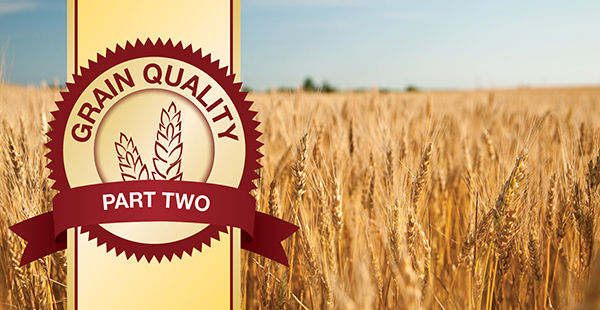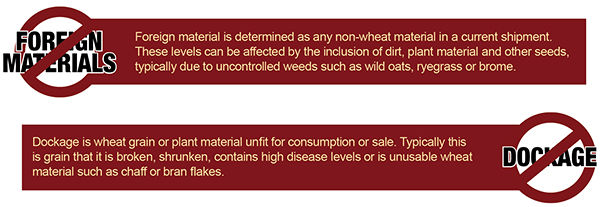Part 2: Lose the Baggage — Limiting Foreign Materials, Dockage in Wheat
October 11, 2019

If you grow wheat, you know grain quality is a focus and is critical to producing a healthy bottom line. But key contributors like grain damage, foreign materials, vomitoxin, test weight and moisture all play important parts in determining year-end profits.
In this second installment of our five-part “Grain Quality” series, we discuss how foreign materials and dockage levels impact grain grading and how it can count against your bottom line at the elevator.
In case you missed the first part of this series on grain quality, please refer to our in-depth analysis on limiting grain damage.
Foreign Materials and Dockage
Foreign material and dockage can impact your bottom line, so it’s important to know the causitive factors to their presence in your grain.

Foreign material is determined as any non-wheat material in a current shipment. These levels can be affected by the inclusion of dirt, plant material and other seeds, typically due to uncontrolled weeds such as wild oats, ryegrass or brome.
Dockage is wheat grain or plant material unfit for consumption or sale. Typically this is grain that it is broken, shrunken, contains high disease levels or is unusable wheat material such as chaff or bran flakes.
The percentages of foreign materials and dockage can be direct indicators of problems that typically occur in the field, before harvest begins. Factors such as disease and weed pressure are key contributors and as these levels rise, they can negatively affect the price of your grain.
Inputs Matter
Jochum Wiersma, Associate Professor and Extension agronomist outreach for the University of Minnesota, says that growers should put themselves in the best position to limit foreign materials and dockage levels. That means using the best inputs that limit weed and disease pressure consistently.
“Wheat growing requires significant planning and commitment to minimize loss,” said Wiersma. “If inputs make sense based on field conditions, go ahead and use them. You cannot take every input away with slim margins if they will help increase bushels per acre.”
Jody Wynia, Cereals marketing manager, agrees adding that growers should have a solid weed-management program in place that eliminates weeds early, limits escapes and minimizes late season pressure so their seeds and plant material don’t end up in your grain.
To limit foreign material from pesky weeds like marestail and kochia, flexible herbicide applications of a tough product like Huskie Complete are a solid strategy. For states where Huskie Complete® is not registered, a herbicide like Olympus® can wipe out a wide range of weeds and brome species in wheat.
“It’s important to make sure you give yourself the best chance at a clean field for the entire season,” added Wynia. “But also make sure that you have an effective disease-management program as well. If overlooked, disease pressure can affect kernel integrity and lead to higher dockage levels at harvest.”
Fungicide products like Prosaro® are an effective choice for growers, especially during seasons with heavy disease pressure. Disease can limit yield loss and the colonization of head and leaf tissue, reducing grain shrinkage and damage. All of which can affect dockage levels at harvest.

“Growers need to focus on producing the best wheat possible based on the lowest price per bushel, not lowest price per acre. If an input improves bushels or protects quality, then it should be considered.”
- Jochum Wiersmar
Harvest: A Deciding Factor
Just as important as planning is for a strong growing season, so is harvest time. Wiersma recommends that growers pay attention to controllable factors during harvest to ensure quality grain shipments.
“You can do some pretty simple things during harvest to limit discounts at the elevator,” said Wiersma. “To eliminate some foreign material, growers can turn up their blower speed to expel plant material, broken and light grains, and weed seeds.”
Others tricks can be as simple as running the combine slower to maintain kernel quality. More importantly, Wiersma says that a timely harvest will drastically impact grain quality.
“Managing wheat really depends on a variety of factors. Right now, we don’t have a cookbook to tell growers what to do each year and every year,” said Wiersma. “Growers need to focus on producing the best wheat possible based on the lowest price per bushel, not lowest price per acre. If an input improves bushels or protects quality, then it should be considered.”
Yet, the best strategy for limiting losses from dockage and foreign materials is still a preventative one, meaning effective fungicide applications that keep fungal disease at bay to protect grain quality and strong herbicide programs that eliminate weed pressure for season-long control.
Check back next month, when we take a look at vomitoxin management.
Have a grain quality story about wheat to share? Tweet us - @Bayer4CropsUS.
For more information about grain quality in wheat visit www.CropScience.Bayer.us, call 1-866-99-BAYER (1-866-992-21937) or talk with your local sales representative.
Keep grain quality king and maximize wheat yields with these other interesting articles...